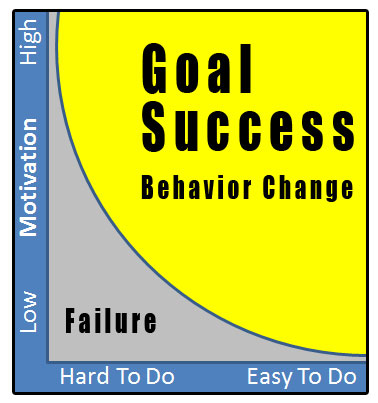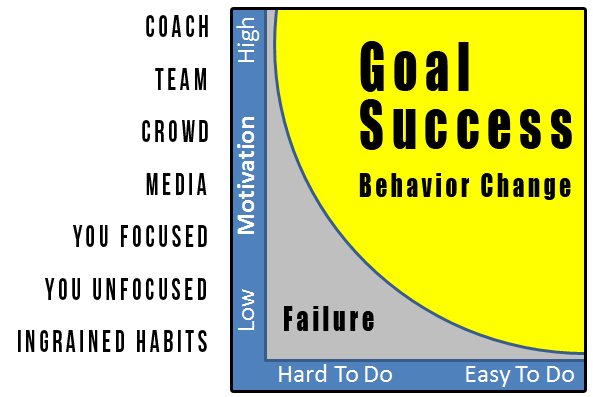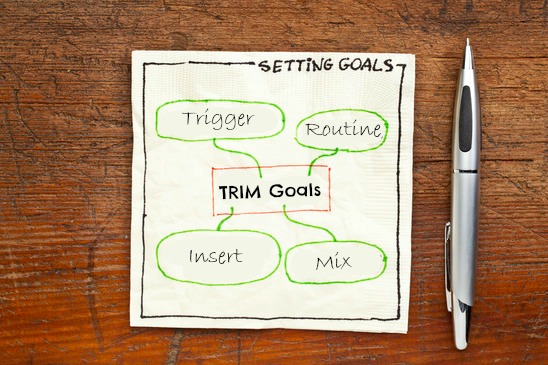I’ve been setting goals for years and have written about goal setting extensively. I’ve also written and published an eBook on goal setting, but through it all I have had one nagging problem.
Goal setting only worked part of the time. I’ve had some amazing, almost impossible goals come to fruition. Yet I’ve had very straightforward SMART goals, laid out to the tee, fail miserably. I’ve also had very simple goals work like a charm, but others seemingly easy ones fail in just a few days.
It always seemed to me that really hard goals worked, and also very simple ones. It was the ones in the middle, the well planned out ones, with a complete plan, that crashed and burned. It wasn’t until I ran into some goal setting research by Stanford professor, Dr. B. J. Fogg that things started to make sense. Once he put up a graph it all clicked. This simple visual showed me clearly what I had experienced for years.
Here is the graph…
The vertical axis represents motivation, from low to high. The horizontal axis represents how hard something is to do, with a declining scale from hard to easy. The yellow represents successful behavior change, while the grey is the failure area. As you can see from the graph, there are two areas almost touching the axis. They are…
- High Motivation combined with a task that is hard to do
- Low Motivation with a task that is easy to do
The middle grey area is the tricky part. If we set a goal to do something very difficult and don’t have enough motivation, we will fail. Conversely, if we have a lot of motivation, but an unchallenging task, we will fail too.
This is exactly what I have experienced in my life. When I have worked with a coach or other motivator on really tough challenges I have seen incredible success.
Here is a short list of some motivated goal successes I have experienced.
- Completing a Triathlon
- Facilitating a Major Conference
- Losing 26 pounds in 12 weeks
- Taking on major leadership positions
Conversely, I have also experienced great success by making small changes to an existing routine or habit. (SMARTER Goals)
- Changed from drinking sugary soda to unsweetened iced tea.
Lost weight over time. - Changed from listening to the radio while commuting to audio books.
Major learning advance - Changed from using an ATM card to using cash.
Saved considerable money over time. - Deposited a small amount in to savings from each paycheck.
Savings compounded over time.
Here are some of my goal failures. Great intentions, yet in the grey area.
- Trying to prepare for a second Triathlon without a coach
(less motivation) - SMART Goal to lose ten pounds
(Too hard and not big enough to be motivating) - Trying to blog everyday
(Too hard and not enough reward) - Taking on an Organization’s Leadership position I wasn’t motivated to do
I wish I would have had this graph and knowledge years ago. I have wasted considerable time and effort in my life in the grey area. With just some simple tweaks almost everything on my failure list could either have been avoided or modified for success.
Looking at the list above I would make these simple changes
- Choose a different Triathlon and work with a coach
- Modify an existing eating habit instead of SMART Goal
- I wouldn’t have attempted to blog each day
- Would have bypassed the unchallenging leadership position
Personally this graph is one of the most enlightening tools I’ve run into in my eight years of blogging. It answers a lot of questions I’ve had and will ultimately help me make better decisions. Tomorrow we’ll look at a powerful Motivation gradient and see how it can be plotted accurately in this graph. The resulting chart will allow us to accurately set goals and ultimately plan out our success. Stay tuned.
SMARTER Goals Can Help You Find Success
Episode 1: Goals Vs. Habits
Episode 2: Fight Training
Episode 3: SMARTER Goals
Episode 4: Testing & Fine Tuning Your Goals
Episode 5: SMARTER Goals for Life
Free Goal Setting Tools
Goal Setting Toolkit
Goal Setting Worksheet
Goal Setting Ebook
Goals for Life: Set SMARTER Goals for Success
Goal Setting Quotes
Inspirational Goal Setting Quotes
The post This Simple Graph Made Goal Setting Click! appeared first on Personal Success Today by John Richardson

















